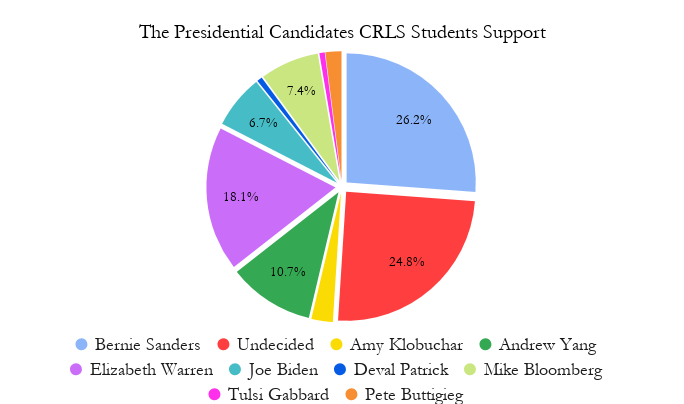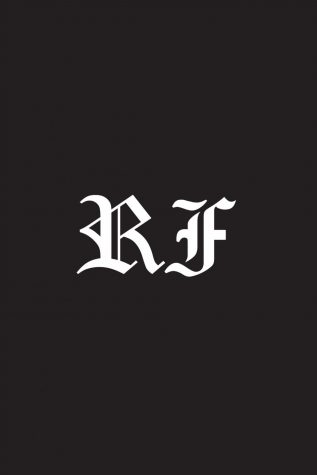Democratic Primaries Begin
CRLS Students Make Their Choices Known
March 5, 2020
This article was written before the South Carolina primary on February 29th and before Super Tuesday on March 3rd.
A poll conducted by the Register Forum at CRLS asking students which Democratic candidate they support shows that Bernie Sanders is in the lead with 26.2% of those surveyed saying they’d cast their vote for him. Meanwhile, Elizabeth Warren received 18.1%, and Andrew Yang got 10.7%. A large percentage (24.8%) remains undecided. When asked why she would vote for Bernie Sanders, Adeline Vidolove ’21 said, “He seems to be for the working people, supporting minorities, and helping the environment.” Zane Ghaemi ’21 added that “all the other Democratic candidates are not left-wing enough, and Bernie has been a man of great character his whole political career.”
As for the national response, the Iowa Caucus kicked off the process on February 3rd with a big stumble: In an effort to modernize its election system, the Iowa state Democratic Party recently decided it would use an app for individual precinct captains to report results to the state’s Party headquarters. Yet, as later reported, this app caused incredible difficulties and ended in total malfunction, leading to the single established backup phone line being flooded by the state’s numerous precinct captains trying to report results.
By 11:00 PM, it became obvious that results would not be reported for some time due to the state party’s mishandling of ballots. This mistake ended up delaying public results for days and gave the eventual essentially-tied winners—Pete Buttigieg, former mayor of South Bend Indiana, and Bernie Sanders, current Vermont senator—significantly less of the boost that Iowa winners expect to receive. Harold Klapper ’21 said of the matter, “I think since it took a while to come out, it didn’t really give one specific candidate the boost that they might’ve needed, so I think it just looks bad for the Democratic Party in general.”
Although the results were muddled and lacked clarity for many days, the eventual reported virtual tie between Sanders and Buttigieg indicates the rise of two lanes in the Democratic Party, represented by the progressive Sanders and the more moderate Buttigieg. Buttigieg, who won a slight edge in state delegate total (an essential equivalent to a statewide version of the electoral college), has outperformed every single initial prediction of his campaign. Conversely, Sanders represents a culmination of a progressive movement years in the making, one that first hit mainstream America during the 2016 Democratic Primaries.
After the night’s overwhelming failure, Democrats as a whole began calling into question the Democratic Party’s primary system. The idea that the Democratic Party—a party built on diversity— holds its first public contest in Iowa, a state that is 90.7% white, has led to outrage among many Democrats. Furthermore, the first-in-line nature of Iowa leads essentially all candidates to fixate much of their campaign’s resources on Iowa in hopes of receiving the large momentum, while in many people’s minds Iowa shouldn’t be given this immense power. Nacie Loh ’20 believes that “the whole election system is set up in a way that is supposed to exclude the votes of people of color and minority groups, so it is not surprising that the primary system is [as well].”
Although many Democrats took away from the results in Iowa the necessity of change to the Democratic Party’s primary system, Democrats have a new problem in the lower than expected turnout in Iowa. With recent special elections since Donald Trump’s ascension to the Oval Office garnering unheard of Democratic voter turnout, there had been many predictions that Iowa’s turnout would be historic.
The record 240,000 voters set during the enthusiastic 2008 race for the Democratic nomination between Barack Obama and Hillary Clinton was expected to be broken by some analysts, however, the number barely reached 2016 levels of turnout. With Trump’s firm hold on the Republican Party, a 49% approval rating in a recent Gallup poll, and a growing economy he can campaign on, immense pressure has been placed on Democrats to find a legitimately electable candidate who can both unite and energize the party.
It’s hard to predict what will happen in the primaries moving forward. In the New Hampshire primary on February 11th, Sanders and Buttigieg continued their neck-to-neck lead over other candidates, with Sanders slightly outpacing the former Indiana mayor, but the Vermont senator surged forward in Nevada on February 24th, capturing 46.8% of the vote.
This piece also appears in our February 2020 print edition.










